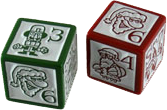In an edited form, this is going into the Dork Tower FAQ page.
This Christmas I recieved a card game called Mag Blast from my little brother, and although the game is excellent, what really caught my eye was the fantastic job the artists did on the cards. I did a little research and have since read some of your dork tower comic strip online and found a few other games you made the art for. As an aspiring art student I was hoping you could share a few of the styles/books/or anything at all that helped you to arrive at your current style of cartooning. Also, would you happen to know where to find any how-to draw cartoon books or tutorials you’ve contributed to? If not, I still really enjoy your art and I hope to see more of it in the coming months.
Finding your own style is perhaps the most challenging aspect of becoming a cartoonist. For the most part, it just happens after years of trying and working at it, with all the changes that happen along the way amalgamated into something new. Most of these changes you don’t even notice, until, one day, you have your own style.
Mostly, when I was in school, I just read other cartoonists whose work I liked. Mostly, they had clean, uncluttered styles, and that’s what I tried to emulate. Charles Schulz and Johnny Hart were perhaps my favorite cartoonists back then, and Schulz is still a major influence on my work (I haven’t been able to stand reading B.C. for over a decade now, but in the late 70’s, I thought it was brilliant). I picked up bits and pieces from others (the Carol Lay mouths, which I ratchet up to 11, for example), and eventually ended up at the style I have now.
If you’re interested in cartooning, my only advice is to keep a sketchbook and draw and sketch as often as you can, trying new things whenever they strike your fancy.
I’ve never used any how-to books, and I never took any classes on cartooning, but I’d recommend general art classes, which is what you seem to be doing. Not for learning how to draw, but for learning how to look at things. It seems strange, but it was a great help. Many people draw what they think they see, and not what they actually see. Cartooning (to me) seems to be the art of trying to say a lot with a few lines. Often what you cut out is as important as what you leave in. So seeing the essence of something is important.
If there’s one book on being a cartoonist I could recommend without reservation, it’s Scott McCloud’s “Making Comics,” perhaps the finest compilation on the subject.
Other than that, all I can do is repeat the words Charles Schulz was kind enough to write me, years ago, well before I knew exactly how critically important they were: “work as hard as you can, and always be yourself.”


